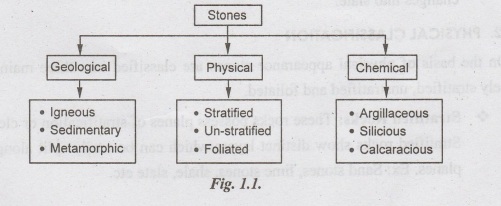Construction Materials And Technology: UNIT I: Stones-Bricks-Concrete Blocks-Lime
Classification of Stones
Construction Materials
In general stones used for civil construction works may be classified into the three ways. 1. Geological Classification 2. Physical Classification 3. Chemical Classification
CLASSIFICATION OF STONES

In
general stones used for civil construction works may be classified into the
three ways.
1. GEOLOGICAL CLASSIFICATION
Geological
classification is based on the mode of formation. On the basis of Geological
formation stones are classified into three main forms namely igneous,
sedimentary and metamorphic.
❖ Igneous Rocks: Igneous rocks are formed by cooling
and solidification of the molten mass lying above or below the surface of the
earth. In general igneous rocks are strong and durable. Ex: Granite, trap and
basalt. Granites have crystalline surface since they are formed by slow cooling
of the molten mass under thick layer on the top surface. Non-crystalline and
glassy textures are formed by the cooling of the molten mass at the top
surface. Ex: Basalt and trap.
❖ Sedimentary Rocks: Sedimentary rock properties differ
considerably based on the nature of sediment and bonding between the sediment
and grains. These rocks thus formed are fine grained, more uniform and dense in
their nature. In general they represent a bedded or stratified structure. Ex:
Sand stones, lime stones, mud stones, chalk etc.
❖ Metamorphic Rocks: Metamorphic Rocks are formed from
igneous and sedimentary rocks, since they undergo changes because of
metamorphic action of internal heat and pressure. Due to the metamorphic
action, granite changes to greisses, trap and basalt becomes schist and
laterite, lime stone changes to marble, sand stone becomes quartzite and mud
stone changes into slate.
2. PHYSICAL CLASSIFICATION
On the basis of physical appearance
stones are classified into three main forms namely stratified, unstratified and
foliated.
❖
Stratified Rocks:
These rocks possess planes of stratification or cleavage. Stratified rocks show
distinct layers which can be easily split along these planes. Ex: Sand stones,
lime stones, shale, slate etc.
❖ Unstratified Rocks: These rocks possess compact grains
and crystalline. These rocks are not stratified and cannot be split into thin
layers. Ex: Granite, marble, basalt, etc.
❖ Foliated Rocks: These rocks have a tendency to split up in a distinct direction. In general most of the metamorphic rocks have a foliated structure, whereas quartzite and marble have granulose structure.
3. CHEMICAL CLASSIFICATION
On
the basis of chemical characteristics stones are categorized into Silicious,
Argillaceous and calcareous rocks.
❖
Silicious Rocks:
These rocks are very hard and durable. The primary- constituent is silica (SiO2).
Ex: Granite, sandstones, trap etc.
❖ Argillaceous Rocks: These rocks are hard, durable and
brittle in nature. The primary constituent is silica (Al2O3).
Ex: Slate, laterite etc.
❖ Calcareous Rocks: These rocks are formed from a
variety of chemical and detrital sediments. The primary constituent is calcium
carbonate (CaCO2). Ex: Limestone, marble, dolomite etc.
Construction Materials And Technology: UNIT I: Stones-Bricks-Concrete Blocks-Lime : Tag: : Construction Materials - Classification of Stones
Related Topics
Related Subjects
Construction Materials and Technology
CE3302 3rd Semester Civil Dept 2021 Regulation | 3rd Semester Civil Dept 2021 Regulation
